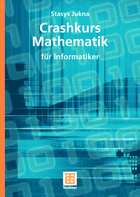 | S. Jukna |
Link zur Vorlesung
Kleine Ausschnitte aus dem Buch:
- pdf Kapitel 0: Schulstoff
- pdf Graphen: Ein Modellierungsbeispiel
- pdf Induktion kann gefährlich sein!
- pdf Bekanntschaften ohne gemeinsamen Bekannten
- pdf Ist Kombinatorik nur etwas für Kinder?
- pdf Perfekte Quadrate: Ein verrücktes Hotel ...
- pdf Komplexe Zahlen: Rechnen in der Zahlenebene
- pdf Lineare Abbildungen als Drehungen
- pdf Was haben homogene Gleichhungssysteme mit Graphen zu tun?
- pdf Die Lineare-Algebra-Methode
- pdf Orthogonale Projektionen und Kommunikation
- pdf Matrixpotenzen und die Ökonomie
- pdf Determinante als Flächeninhalt
- pdf Eigenwerte machen das Leben leichter
- pdf Harmonische Reihe und ein "Bauparadoxon"
- pdf Geometrische Reihe -- die Mutter aller Reihen
- pdf Grenzwert als Approximation des Unbekannten
- pdf Das Master-Theorem
- pdf Integrale als "Hilfsmittel gegen Reihen"
- pdf Stochastische Unabhängigkeit, wie die Schönheit, ist sehr selten
- pdf Erwartungswert als Schwerpunkt
- pdf Würfle und beweise: Die probabilistische Methode
Meinungen der Leser:
-
The book's intention is to give an introduction into the mathematics which is needed for computer science and to do this in a way stressing the specific view of a student of computer science. It presupposes as little mathematical knowledge as possible. There is even a short repetition of college stuff. The main part is divided into five chapters: I. Sets, logic and combinatorics, II. Algebra and number theory, III. Linear algebra, IV. Calculus, V. Discrete stochastics. Graph theory has not got a chapter of its own, but graph theoretic topics are found as examples and applications all over, especially in the first chapter, but also in the last, where the probabilistic proof method is applied to Ramsey graphs.
In the first chapter much care has been given to explain proof techniques (e.g. pigeon hole principle, double counting) and to advise against traps and pitfalls when using logical deduction or induction. Lots of examples give a strong motivation for the concepts, which are always introduced using vivid examples. Along the way the reader is also introduced into the construction of algorithms and their complexity (i.e. knapsack problem). Of course this is no substitute for a systematic exposition. Main applications are RSA encryption and a fast probabilistic test of equality for large numbers. This chapter probably serves best the intentions of the author.
In comparison the other chapters are more conventional. Chapter II gives a solid introduction into algebraic structures from groups to Galois fields, and with fast Fourier transforms as an application. Chapter III gives good visualisations of matrix and vector operations and covers the standard topics as far as Gram-Schmidt orthogonalization and eigen vectors, applications are error correcting codes and Ramsey graphs. In chapter IV recurrence equations are solved by a clever usage of suitable transformations, a clear, but rarely found approach. After introducing Landau symbols a master theorem is proved for solving some nonlinear recurrence equations, which often emerge when estimating the time complexity of algorithms. Chapter V, which is substantially shorter, has the well-known birthday paradox and others and handles the inequalities of Markov, Chebyshev and Chernov in detail and with an application to job control.
All the theorems are with complete proofs. There are many exercises (with solutions available online), several of them extending the material.
Zentralblatt für Mathematik. Reviewer: Dieter Riebesehl (Lüneburg)
- Ziel des vorliegenden Buches ist es, eine einsemestrige Einführung in die Mathematik
zu geben, wobei die Stoffauswahl im Hinblick auf Relevanz für die Informatik
getroffen wurde: Es beginnt mit den Grundlagen der Mengenlehre, Logik und
Kombinatorik, um dann ausgewählte Themen aus Algebra, Zahlentheorie, Lineare
Algebra, etwas Analysis und diskrete Wahrscheinlichkeitstheorie zu behandeln.
Das Buch ist insgesamt locker geschrieben und die Inhalte werden immer wieder
mit leicht verständlichen Beispielen veranschaulicht. Ausserdem bemüht sich der
Autor regelmässig, den Bezug zur Informatik herzustellen. Eine grosse Anzahl von
netten Übungsaufgaben rundet das Buch ab (Musterlösungen dazu sowie Zusatzmaterialien
werden auf der Webseite des Autors bereitgestellt).
Insgesamt halte ich es für einen netten Leitfaden, der eine leicht verdaubare Übersicht
über die für Informatiker relevante Mathematik gibt und die Brücke zur vertiefenden
Literatur schlagen kann.
- Meinung
von Sabine Hunsicker
"Man kann Mathematik nicht komplett in der Alltagssprache erklären, doch Jukna erklärt die mathematischen Fachbegriffe gut und schafft es auch, den Text trotz aller Formeln und Definitionen lesbar zu halten. Juknas Ziel ist es, das mathematische Wissen zu vermitteln, das ein Informatikstudent im ersten Semester braucht, um die Grundlagen zu verstehen. Das ist ihm voll und ganz gelungen. Es wird nur sehr wenig Wissen vorausgesetzt; gerade so viel, dass auch jemand, der schon seit längerem nicht mehr die Schulbank gedrückt hat, dem Gesagten folgen kann. Wegen der Kürze des Buches und der Fülle des Stoffes können nicht alle Einzelheiten erwähnt werden, aber das ist auch nicht Ziel des Autors. Bei einigen Gebieten, wie etwa der Graphentheorie, geht er davon aus, dass in späteren Lesungen detaillierter darüber gesprochen wird, daher wird hier wirklich nur das Allerwichtigste erwähnt. Doch um die Grundlagen für ebenjene späteren Vorlesungen zu schaffen, reicht es allemal aus. Das Buch richtet sich in seiner Gesamtheit an Erstsemester oder angehende Informatikstudenten, die sich schon etwas auf die ersten Vorlesungen vorbereiten wollen. Für diese wird es kein besseres Einstiegswerk geben, das in dieser Kürze doch alle wichtigen Begriffe nennt und erklärt. Für diejenigen, die sich etwas genauer mit dem einen oder anderen Thema befassen wollen, nennt der Autor am Schluss einige spezialisierte Bücher.
Auch wer sonst seine Mathekenntnisse etwas auffrischen will, dem sei zu diesem Buch geraten. Wer allerdings schon einige Mathevorlesungen gehört hat, dem wird dieses Buch zu flach sein - für diesen Personenkreis ist es aber auch nicht intendiert. Ein schönes Einsteigerbuch, das gut auf das Studium vorbereitet und trotzdem die Lust an Mathe nicht verleidet."